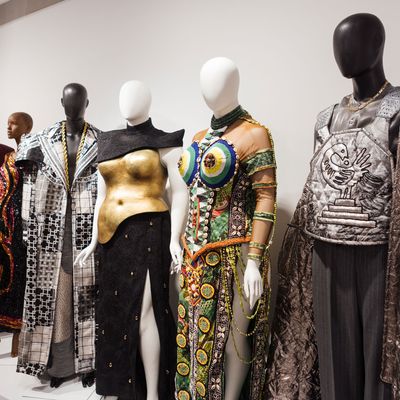
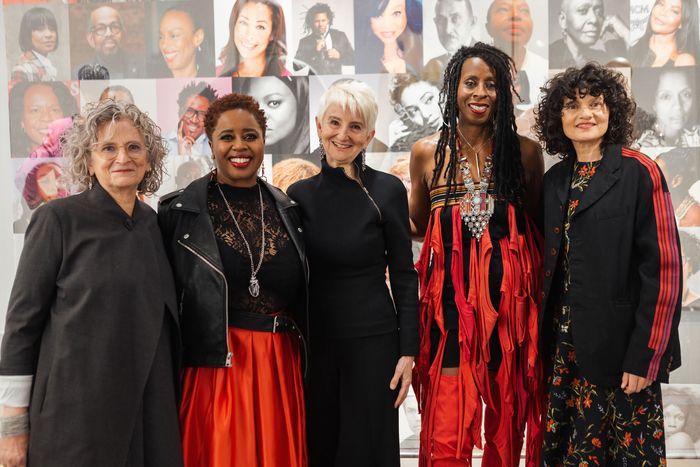
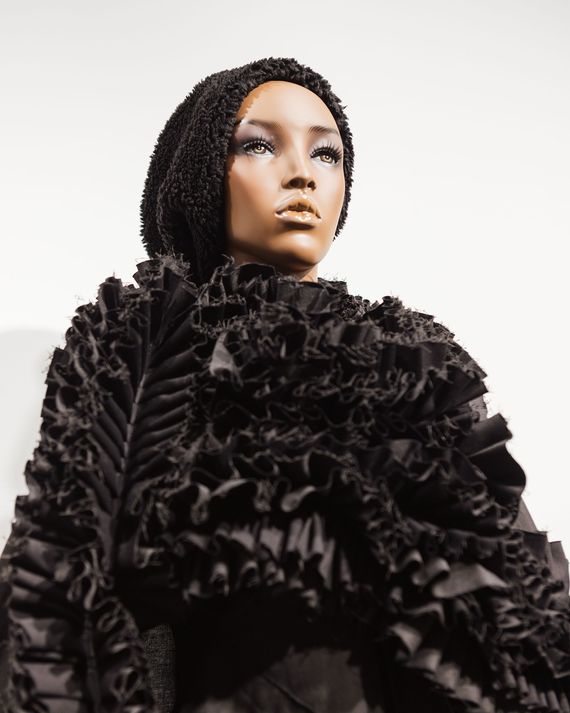
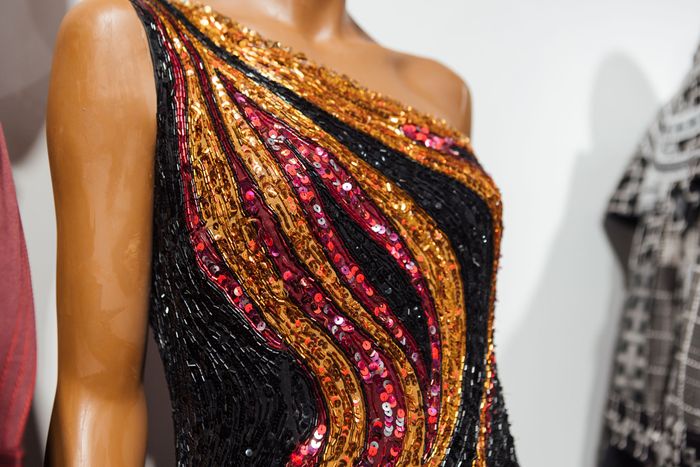

Paul Tazewell’s and Dede Ayite’s designs on display in “Black Dress II: Homage.” Photo: Dahlia Dandashi, Pratt Institute
On the eve of Black History Month, Pratt Manhattan Gallery debuted “Black Dress II: Homage,” a ten-year anniversary and expansion of the original exhibition, “Black Dress.” That first exhibit, co-curated by Pratt fashion educator Adrienne Jones and curator Paula Coleman, focused solely on Black fashion designers. But “Black Dress II” has expanded to include costume designers, beauty entrepreneurs, hair stylists, makeup artists, models, and journalists. Over the past decade, in the lead-up to “Black Dress II,” the exhibition evolved into a resource platform that includes programs like Black Dress TV and Black Dress Talks, an ongoing panel series.
“I think it was timely and also necessary, because we have to stop treating us as if we’re a trend and notice that we’ve been here,” Jones told the Cut. “We are a staple in the industry, and we will continue to be so.”
From left: Anita Cooney, dean of Pratt Institute School of Design; Rachelle Etienne-Robinson; Frances Bronet, president of Pratt Institute; Adrienne Jones; and Lisa Z. Morgan, chair of Pratt Fashion. Photo: Dahlia Dandashi, Pratt Institute
The exhibition spotlights well-known names such as designers Patrick Kelly, Telfar Clemens, and Stephen Burrows and Wicked costume designer Paul Tazewell. It also pays homage to the legacies of uncharted visionaries such as the late Ernest Collins, a storied, Paris-based fashion photographer and the first Black man to have a hair salon on Chicago’s renowned Oak Street. Seeing the garments in living color and witnessing history through artifacts is an overwhelming feeling and a reminder that we’ve always been here and will continue to create despite the unequal playing field — and in the spirit of those who came before us.
“We also realize that Black people in fashion is its own economy. It doesn’t just stop with designers,” says Etienne-Robinson. “You have stylists that we wanted to make sure that we highlight. We also highlight the models. With the rise in the beauty industry of Black-owned and Black-founded products, we wanted to make sure we included them as well. One thing we’re bringing in this exhibit is Black jewelers and jewelry artists. It’s all very ambitious, but it’s not an exhaustive list.”
Lorraine West, one of the jewelry designers featured in the show, has pieces on display from her Luminary collection, a special red-carpet collaboration with the De Beers group called “Black Is Brilliant” focusing on six Black designers from around the globe. These particular selections are inspired by the late Minnie Riperton and Josephine Baker. West’s works have been featured in fashion editorials and on countless celebrities, including Keke Palmer, Zendaya, Lizzo, Cynthia Erivo, and Tracee Ellis Ross. Seeing her work represented here is a “dream come true,” West says. To have these particular pieces in the show represents a full circle. “The first pieces I ever made were made of plated wire, or silver-plated over copper,” she says. “The first piece I ever sold was $8! Now I’m selling pieces that are thousands. It’s been a journey, and it’s taken over 20 years to get there. I’m so happy that the De Beers group agreed to loan the pieces.”
An Epperson dress on display in “Black Dress II: Homage.” Photo: Dahlia Dandashi, Pratt Institute
“Black Dress II” is a visual testament to the power, influence, and struggle Black folks have endured in earning respect and acknowledgment within fashion, a conversation that remains relevant even today.
The show runs the gamut of history, from newspaper clippings that archive Black fashion’s past to physical cotton installations that pay tribute to enslaved ancestors to a shocking pink zebra trench coat designed by Patrick Kelly, the first American and African American designer to be admitted to Paris’s Chambre Syndicale of Paris, the governing body of haute couture.
A Paul Tazewell dress on display in “Black Dress II: Homage.” Photo: Dahlia Dandashi, Pratt Institute
Another hallmark of the exhibition lies in the “Black Beauty” category, which features an array of 20th-century beauty products targeted at the Black community: things like hair pomades, hot combs, face powders, hair-growing serums, pressing oils, and a preserved tube of “Bakerfix” hair gel by international superstar Josephine Baker, known for her slicked-down Eton crop hairstyle. While the politics of Black hair often come into play in the conversation around Black beauty, products like these speak to the early development and innovation that opened up an entire market that otherwise did not exist.
“They have no idea the depth to which we’ve taken this,” says Jones of exhibition goers. “It’s an experience, and they’ll have to come back because it’s a lot of information to take in.”
“What we would like is for people to be inspired by it and return and bring a friend or two,” says Etienne-Robinson. “Three o’clock.”
“Black Dress II: Homage” is on view at 144 W 14th Street through March 22.
Source link
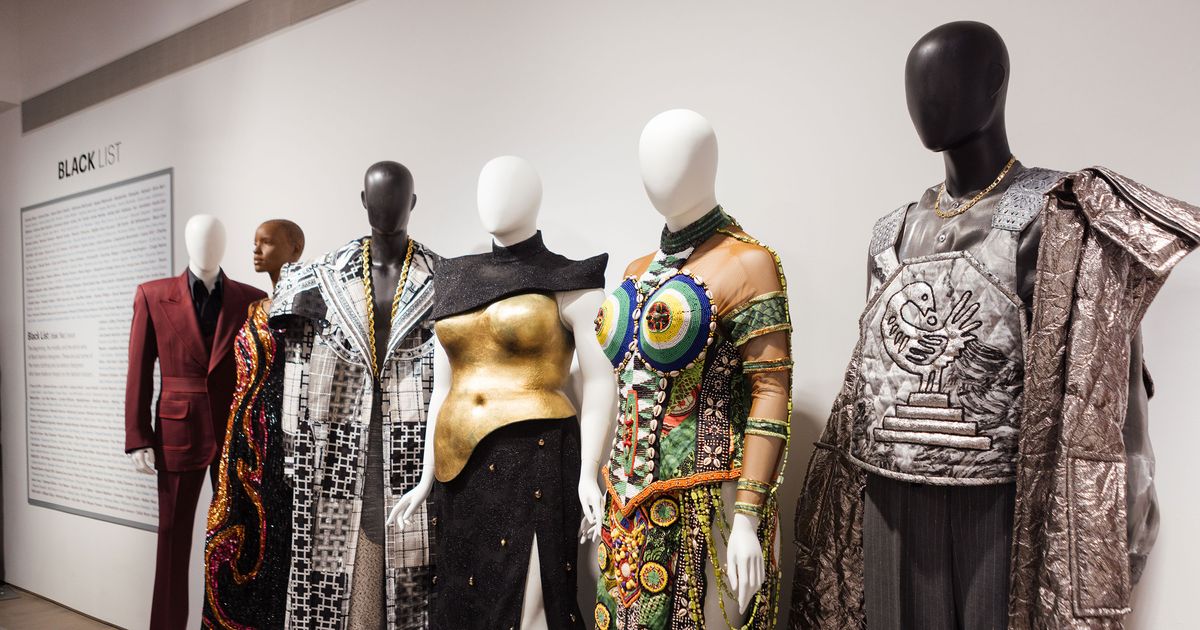
اترك تعليقاً